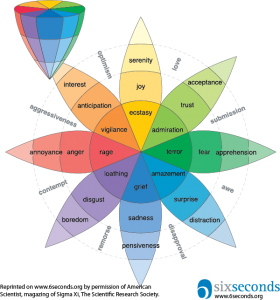What does it mean to feel, and why does it happen? When we look at emotions as “good” or “bad” we’re in a constant state of internal struggle against our own emotions. Is there another option? How can we shift away from this dualistic view and make friends with ALL our feelings? This article includes Josh’s feeling list (explained at the end of the article) you can access with the button:
by Joshua Freedman
Original article: https://www.6seconds.org/2020/08/17/integrated-emotions/
Imagine the “archetypal” child and parent, let’s take a boy, about eight years old. His parent is busy dealing with 3.3 million tasks and chores, it’s been a long day and everyone’s on thin ice. The child is going about the business of childhood and something happens – almost irrelevant what it is, and he gets upset — it’s been a long day for him too. Let’s suppose he’s highly upset, unreasonably upset, and acts that out: he slams something down, he kicks something, he shouts, and overwhelmed by this rush of feelings (and afraid of his parent’s reaction) he starts to cry.
What is the parent’s typical reaction? Frequently it translates to “stop” – sending a clear message of invalidating the child’s feelings. Most of us have grown up with those messages, and we’ve learned: “Some of our emotions are bad” – but what if that’s wrong?
What if we imagine all feelings (yes, even difficult ones) are here for a reason. Can we reframe our feeling about feelings to make them allies?
Dismissing Feelings
In your own experience with emotion, what did you learn? What’s the story you heard about feelings like anger, fear, hurt, or jealousy?
I’ve been privileged to work with people from over 100 countries, and around the world, people have told me much the same thing: Those are “negative” feelings. Even “bad” feelings. We find them uncomfortable, overwhelming, scary, out-of-control (and now we’re having “bad feelings” about our “bad feelings”).
So, what is the natural, reasonable, response to something bad? Control it. Push it away. Cover it over. Squish it. Or at the very least, hide it. Maybe after some therapy, “manage” it. As Marge Simpson said to Lisa: “Push the bad feeling down down down ’till you’re standing on it, and smile.”
What about embracing these difficult feelings?
Increasingly people are happy to do that with “positive” emotions – the happiness-fad seems to be slowly waning, but there is still a pervasive message: Happiness is good, so if you’re not happy, there’s something wrong. This attitude is fraught with judgment; we’re limiting the motivating power of feelings to a select few. We’re deciding that some emotions are good… which requires that others are bad.
In the last 24 years of teaching about emotions as a driver for positive change, I’ve come to consider that this vilification of our own emotions is the single biggest obstacle to emotional intelligence.
Going Deeper with Pluchik’s Wheel of Emotions
The Plutchik Model offers a beautiful framework for exploring the meaning of emotion. I’ll explain the model and the value of it — and then the fatal flaw of dualistic thinking. Then we’ll look for another view.
If you’ve not explored our interactive version of the Plutchik Model, it will give you insight on why this feelings wheel is so useful, but below I’ll go in more depth about the meanings and the limitations.
Enjoying this article? Visit the original website to read the complete article, download materials and explore other resources embedded in the article: https://www.6seconds.org/2020/08/17/integrated-emotions/



